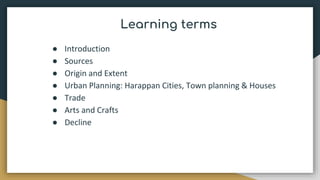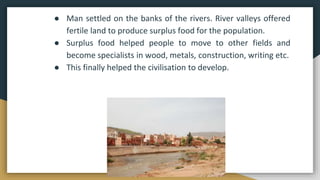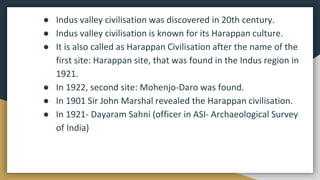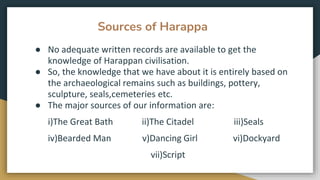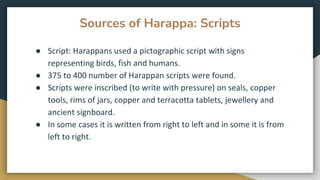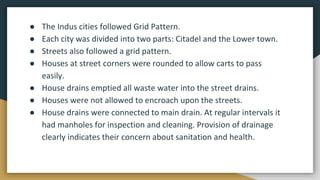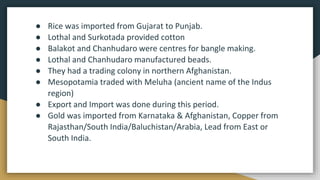Cl-9 Ch-1.pptx
- 2. Learning terms ● Introduction ● Sources ● Origin and Extent ● Urban Planning: Harappan Cities, Town planning & Houses ● Trade ● Arts and Crafts ● Decline
- 3. Introduction ● An advanced stage of human cultural development is called as Civilisation. ● Traits (character/qualities) of civilisation are: ○ Evolution of cities ○ Surplus (extra/excess) Food ○ Division of labour ○ System of writing ○ Monumental (massive/huge) Public buildings ○ Development of technology
- 4. ● Man settled on the banks of the rivers. River valleys offered fertile land to produce surplus food for the population. ● Surplus food helped people to move to other fields and become specialists in wood, metals, construction, writing etc. ● This finally helped the civilisation to develop.
- 5. Chalcolithic period ● Metals replaced stone. Metal was more durable. ● Copper was the first metal that was discovered. ● The period when man used both- STONE and COPPER is called as CHALCOLITHIC Period.
- 6. Bronze age ● Later, Copper was mixed with Tin or Zinc to form an alloy called BRONZE. ● Bronze is more hard and ductile than copper. Hence was used to manufacture tools, utensils and weapons. ● Bronze became important and hence this period was called as Bronze Period. ● And the first civilisations that used Bronze were called as Bronze Age Civilisations. It played an important role in its growth.
- 7. ● Four Bronze Age Civilisations seen were: ○ Harappan Civilisation in Northern and Western parts of India and Pakistan on the banks of the river indus. ○ Mesopotamian Civilisation in Iraq on the banks of the rivers: Euphrates and Tigris. ○ Chinese Civilisation in the valleys of the rivers: Hwany Yo and Yangtze. ○ Egyptian Civilisation in Egypt on the banks of the river Nile.
- 8. ● Indus valley civilisation was discovered in 20th century. ● Indus valley civilisation is known for its Harappan culture. ● It is also called as Harappan Civilisation after the name of the first site: Harappan site, that was found in the Indus region in 1921. ● In 1922, second site: Mohenjo-Daro was found. ● In 1901 Sir John Marshal revealed the Harappan civilisation. ● In 1921- Dayaram Sahni (officer in ASI- Archaeological Survey of India)
- 9. ● In 1922- R.D.Banerjee was led to the site by a Buddhist monk. Monk expected the site to be a Buddhist Stupa. But this was the city of Mohenjo-Daro. ● Mohenjo-Daro - means mound (mountain/heap) of the dead.
- 10. Sources of Harappa ● No adequate written records are available to get the knowledge of Harappan civilisation. ● So, the knowledge that we have about it is entirely based on the archaeological remains such as buildings, pottery, sculpture, seals,cemeteries etc. ● The major sources of our information are: i)The Great Bath ii)The Citadel iii)Seals iv)Bearded Man v)Dancing Girl vi)Dockyard vii)Script
- 11. Sources of harappa:The great bath ● Great Bath: The great bath at Mohenjo-Daro is a huge structure. ● It denotes that the art of building had reached a high degree of perfection. ● It denotes the existence of ruling class which built such huge structures for the public. ● Burnt bricks were used to build it. It had flight of steps on North and South leading to the tank. ● The walls of the pool were made watertight, specially-made bricks and gypsum mortar. ● It might have been used for religious purposes. ● It shows advanced planning with features like water supply and drainage.
- 13. Sources of Harappa:The Citadel ● The raised area of each city was called as the Citadel. ● The area was raised with the help of mud brick platforms. ● Ruling class had their houses in this area along with other important buildings like the Great Bath, Granary, Assembly Hall and the Workshops. ● It denotes advanced planning. We can call it an urban civilisation.
- 14. Sources of Harappa:Seals ● Seals: The seals used by harappans show their artistic skills. ● 2000 seals have been discovered. ● It comprises of seals with one horned bull, buffalo, tiger, goat, elephant and rhinoceros. ● Seals were Rectangular, Square or Circular. Pashupati Seal shows that they believed Shiva. ● Unicorn Seal shows their mythical beliefs. Seals were used by traders to stamp their goods. Seals were pressed on the layer of wet clay after tying the knot to the bag of goods. ● Seals were found in different areas.
- 15. ● From the figures on the seals we came to know about their dress, ornaments, hair-styles and animals. ● It also tells us about their religious life (pashupati seal) ● It also tells us about their trade (seal with ship) & commerce. ● It also tells us about their scripts.
- 16. Sources of Harappa: Bearded Man (Yogi) ● Bearded Man (Yogi): The artistic statue of a man with beard was discovered from Mohenjo-Daro. ● It has a shawl worn over the left shoulder. ● Eyes are half closed hence called as the statue of a Yogi. ● It is made of limestone and its height is 17.5cms.
- 17. Sources of Harappa: Dancing Girl ● Dancing Girl: The bronze statue of a dancing girl was found at Mohenjo-Daro. ● The right hand of the dancing girl rests on the hip. ● Her hair is neatly fashioned in the form of a bund. Her head is tilted slightly backward. ● The left hand is heavily bangled, holding a small bowl against her left leg.
- 18. Sources of Harappa: Dockyard ● Dockyard (sea port/dock): A rectangular dock was discovered at Lothal in Gujarat. ● It was surrounded by a huge brick wall to protect it from floods. ● It was made of baked bricks. ● It was an important sea port of Indus Valley Civilisation used for carrying out overseas trade.
- 19. Sources of Harappa: Scripts ● Script: Harappans used a pictographic script with signs representing birds, fish and humans. ● 375 to 400 number of Harappan scripts were found. ● Scripts were inscribed (to write with pressure) on seals, copper tools, rims of jars, copper and terracotta tablets, jewellery and ancient signboard. ● In some cases it is written from right to left and in some it is from left to right.
- 21. Origin and Extent of Harappan Civilisation ● The urban harappan culture was a result of growth and development of local village cultures. ● It had trade contacts with Mesopotamia. ● The entire area of Harappa is triangular in shape. ● It has the largest area of civilisation: 12,99,600 sq km. ● Sutkagendor {Baluchistan} in West to Amalgirpur {UP} in East ● Manda {Jammu} in North to Bhagatrav in South.
- 22. Urban Planning ● Six Harappan Cities included: ○ Harappa- Montgomery district in Punjab. ○ Mohenjo-Daro in Larkana district in Sindh (now in Pakistan). ○ Both the cities are linked by river Indus hence called as Indus valley civilisation. ○ Chanhudaro {near Mohenjo-Daro- South} ○ Lothal in Gujarat ○ Kalibangan {Rajasthan}
- 23. ● The Indus cities followed Grid Pattern. ● Each city was divided into two parts: Citadel and the Lower town. ● Streets also followed a grid pattern. ● Houses at street corners were rounded to allow carts to pass easily. ● House drains emptied all waste water into the street drains. ● Houses were not allowed to encroach upon the streets. ● House drains were connected to main drain. At regular intervals it had manholes for inspection and cleaning. Provision of drainage clearly indicates their concern about sanitation and health.
- 24. Houses ● Residential buildings were built on high mound to protect from floods. Houses were spacious with rooms and bathrooms. ● Each house had covered drains connected with street drains. ● Houses were single/double storeyed. ● Houses had courtyard and kitchen. ● Houses were made of wood and brick. ● Each house had doors and windows. Doors and windows opened on side of the street and not on the main roads.
- 25. Trade ● Granaries, seals, script, regulated weight and measures in a wide area indicate the existence of a highly developed system of trade. ● Harappans not only traded with others part of India but also with other countries in Asia. ● Barter system was used by them. They traded stone, metal, shell etc. ● Mohenjo-Daro, Harappa and Lothal were important centres for metallurgy. Tools, kitchenware and other objects were produced here.
- 27. ● Rice was imported from Gujarat to Punjab. ● Lothal and Surkotada provided cotton ● Balakot and Chanhudaro were centres for bangle making. ● Lothal and Chanhudaro manufactured beads. ● They had a trading colony in northern Afghanistan. ● Mesopotamia traded with Meluha (ancient name of the Indus region) ● Export and Import was done during this period. ● Gold was imported from Karnataka & Afghanistan, Copper from Rajasthan/South India/Baluchistan/Arabia, Lead from East or South India.
- 28. Arts and Crafts: Art of Carving ● Indus people excelled in the art of carving. The figures of animals show a high degree of perfection. ● Many seals were found with figures of various animals such as bull, buffalo, bison and elephant. ● Different designs and figures of men, animals, birds and trees painted on earthenware show the artistic skills of these people. They painted geometrical patterns if colors on pottery.
- 30. Arts and Crafts:Art of Pottery Harappan potters made pottery of various shapes and sizes on a pottery wheel. Different types of pots and vases were made. Pots for regular use were plain and those used for preserving valuables were glazed and painted.
- 31. Arts and Crafts: Art of Spinning ● A piece of woven cotton was also found along with many textile impressions on several objects pointing us that weaving was an important craft. ● A large number of spindles and whorls were found in their houses. Dyer's vat was also found.
- 32. Decline of the Civilisation 1800 BC Floods and Climate Change:Heavy rainfall affected agriculture and stock breeding. Decrease in fertile land because of the expansion of the near by desert. Sudden floods can be a few reasons for the decline. Deforestation:Indus valley was Bronze Age civilisation so enormous quantities of wood was needed to produce bronze. Wood was also needed to produce jewellery, pottery, bake bricks, boats, furniture etc thus leading to deforestation causing the climatic change. Attack:Aryans might have invaded the city Earthquake

